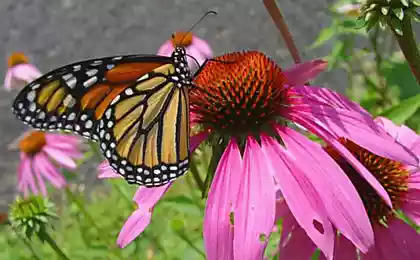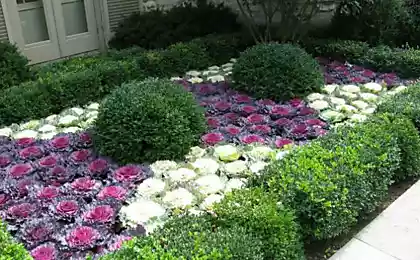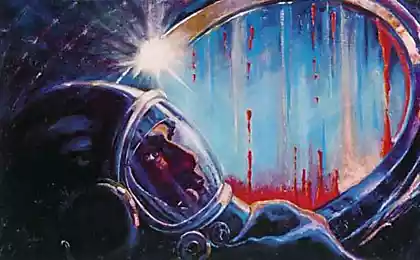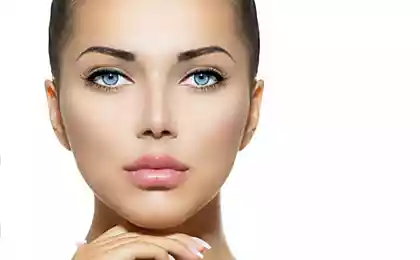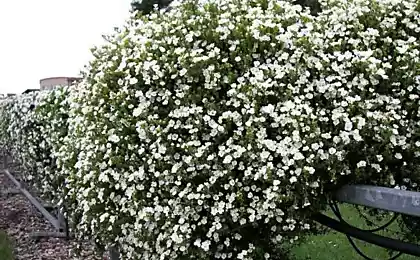478
Echinacea: planting, care and use
Echinacea is a perennial plant with many useful properties, which is sometimes called the "American Daisy", as brought to us it was in the seventeenth century from America.
And if earlier there were only two varieties of this flower with purple and white flowers, today, every grower has the opportunity to choose inflorescences with unusual, bright color. Planting and care of Echinacea do not require much hassle, and the scope of this plant are very extensive.

Planting EchinaceaEchinacea is propagated mainly by seeds sown in closed or in open ground. In late winter, seeds are placed in a box with soil to a depth of 0.5 – 1 cm, cover with sand and moderately watered. The first seedlings appear after 2-5 weeks. It is important that the soil in this period did not dry up, and the earth's temperature did not fall below 13 degrees. In may, the grown seedlings are transplanted in open ground.
In addition to the seed method of propagation of Echinacea used the method of dividing the Bush. The best time for this — spring. Delenki you need to hold in the solution, stimulating the growth of roots (Kornevin, EPIN and so on), and then planted in a new place and not to forget about additional care: watering and periodic fertilizing.
Also great success in the commercial environment uses the meristem method. It is used in the case when you need to quickly and in large numbers to propagate varietal plants, bearing all the characteristics of the parent plants that can bloom in no time. However the plants obtained in the first year is very compact and often sold in stores already blooming.
The meristem method is a complicated method of using apical cuttings by green sprouts from the mother plants of the varietal, with the use of sophisticated biological technologies.
When purchasing Echinacea, reproduced meristeme early spring, provide them rehabilitation and care when planting:
First, the transplant without damaging the root ball in the larger pots with the nutrient mixture;
Second, provide content at an even temperature, out of direct sunlight;
Third, do not forget about moderate watering, avoiding drying of the soil.
When the temperature of soil and air has warmed enough, plant Echinacea in a permanent solar observing interval, depending on the grades: 30 — 60 cm between plants on each side.
If Echinacea purchased at the height of the planting season, help them to adapt to a new place, creating a special microclimate around the plant just re-planted the flower to cover the 5-liter plastic bottle with cut bottom without lid. To keep this cover from 2 weeks to a month depending on how to develop the plant.
Echinacea: planting and careSpeaking about Echinacea, the planting and care of this plant, it should be clarified that it grows best in Sunny areas. To grow healthy, beautiful flowers, observing the following care instructions:
Echinacea is not demanding to soil, but for its active growth in zakislenie better soil add some lime.
plant seeds have in pre-prepared holes about five inches deep. The distance between the bushes 30 to 60 centimeters. Before landing at the bottom of the pits poured a small amount of compost;
in the spring, when the growth of Echinacea is particularly active, is the first top-dressing with mineral and organic fertilizers;
the second and last fertilizing is done during the formation of buds.
Echinacea flowering in the second year of life and continues for three months. To provide proper care for Echinacea, particular attention should be paid to possible diseases and pests of plants.
Mildew and rot often affect Echinacea in the rainy summer. In this case, you must immediately to handle the flowers fungicidal agents.
These are the basic rules of planting and care of Echinacea, with which it can handle even the novice gardener.
Echinacea: use in medical purposes
One of the reasons for the popularity of Echinacea lies in its unique beneficial properties. This medicinal plant is widely used in the treatment of various diseases, effectively combats pathogenic bacteria and helps to strengthen the immune system.
For making decoctions, infusions, teas of Echinacea, often used to fight colds, we need only those plants whose age is not less than two years. As raw materials are about not only flowers, but also the roots, leaves and stems.
Echinacea can be used not only inside but also externally in the treatment of many skin diseases. Thanks to the useful properties possessed by Echinacea, its use is possible and children with various respiratory pathologies.
Important: However, before using Echinacea, you should consult with your doctor, especially if there is a predisposition to allergic reactions (particularly to grass) if age less than 12 years is present or any autoimmune disease. And of course cannot be used to treat Echinacea for pregnant and lactating women.
Studies show that Echinacea contains active substances that enhance the activity of the immune system, relieve pain, reduce inflammation and have antiviral and antioxidant effects.
A common use of Echinacea:
professional herbalists recommend the use of Echinacea to treat urinary tract infections, vaginal infections (candidiasis);
ear infections (also known as otitis media), athlete's foot, sinusitis, hay fever (also called allergic rhinitis);
slow-healing wounds.
Today people use Echinacea to shorten the duration of colds and flu and reduce painful symptoms such as sore throat (pharyngitis), cough and fever.
P. S. And remember, only by changing their consumption — together we change the world! ©
Source: www.mil-sad.ru
And if earlier there were only two varieties of this flower with purple and white flowers, today, every grower has the opportunity to choose inflorescences with unusual, bright color. Planting and care of Echinacea do not require much hassle, and the scope of this plant are very extensive.

Planting EchinaceaEchinacea is propagated mainly by seeds sown in closed or in open ground. In late winter, seeds are placed in a box with soil to a depth of 0.5 – 1 cm, cover with sand and moderately watered. The first seedlings appear after 2-5 weeks. It is important that the soil in this period did not dry up, and the earth's temperature did not fall below 13 degrees. In may, the grown seedlings are transplanted in open ground.
In addition to the seed method of propagation of Echinacea used the method of dividing the Bush. The best time for this — spring. Delenki you need to hold in the solution, stimulating the growth of roots (Kornevin, EPIN and so on), and then planted in a new place and not to forget about additional care: watering and periodic fertilizing.
Also great success in the commercial environment uses the meristem method. It is used in the case when you need to quickly and in large numbers to propagate varietal plants, bearing all the characteristics of the parent plants that can bloom in no time. However the plants obtained in the first year is very compact and often sold in stores already blooming.
The meristem method is a complicated method of using apical cuttings by green sprouts from the mother plants of the varietal, with the use of sophisticated biological technologies.
When purchasing Echinacea, reproduced meristeme early spring, provide them rehabilitation and care when planting:
First, the transplant without damaging the root ball in the larger pots with the nutrient mixture;
Second, provide content at an even temperature, out of direct sunlight;
Third, do not forget about moderate watering, avoiding drying of the soil.
When the temperature of soil and air has warmed enough, plant Echinacea in a permanent solar observing interval, depending on the grades: 30 — 60 cm between plants on each side.
If Echinacea purchased at the height of the planting season, help them to adapt to a new place, creating a special microclimate around the plant just re-planted the flower to cover the 5-liter plastic bottle with cut bottom without lid. To keep this cover from 2 weeks to a month depending on how to develop the plant.
Echinacea: planting and careSpeaking about Echinacea, the planting and care of this plant, it should be clarified that it grows best in Sunny areas. To grow healthy, beautiful flowers, observing the following care instructions:
Echinacea is not demanding to soil, but for its active growth in zakislenie better soil add some lime.
plant seeds have in pre-prepared holes about five inches deep. The distance between the bushes 30 to 60 centimeters. Before landing at the bottom of the pits poured a small amount of compost;
in the spring, when the growth of Echinacea is particularly active, is the first top-dressing with mineral and organic fertilizers;
the second and last fertilizing is done during the formation of buds.
Echinacea flowering in the second year of life and continues for three months. To provide proper care for Echinacea, particular attention should be paid to possible diseases and pests of plants.
Mildew and rot often affect Echinacea in the rainy summer. In this case, you must immediately to handle the flowers fungicidal agents.
These are the basic rules of planting and care of Echinacea, with which it can handle even the novice gardener.
Echinacea: use in medical purposes
One of the reasons for the popularity of Echinacea lies in its unique beneficial properties. This medicinal plant is widely used in the treatment of various diseases, effectively combats pathogenic bacteria and helps to strengthen the immune system.
For making decoctions, infusions, teas of Echinacea, often used to fight colds, we need only those plants whose age is not less than two years. As raw materials are about not only flowers, but also the roots, leaves and stems.
Echinacea can be used not only inside but also externally in the treatment of many skin diseases. Thanks to the useful properties possessed by Echinacea, its use is possible and children with various respiratory pathologies.
Important: However, before using Echinacea, you should consult with your doctor, especially if there is a predisposition to allergic reactions (particularly to grass) if age less than 12 years is present or any autoimmune disease. And of course cannot be used to treat Echinacea for pregnant and lactating women.
Studies show that Echinacea contains active substances that enhance the activity of the immune system, relieve pain, reduce inflammation and have antiviral and antioxidant effects.
A common use of Echinacea:
professional herbalists recommend the use of Echinacea to treat urinary tract infections, vaginal infections (candidiasis);
ear infections (also known as otitis media), athlete's foot, sinusitis, hay fever (also called allergic rhinitis);
slow-healing wounds.
Today people use Echinacea to shorten the duration of colds and flu and reduce painful symptoms such as sore throat (pharyngitis), cough and fever.
P. S. And remember, only by changing their consumption — together we change the world! ©
Source: www.mil-sad.ru


